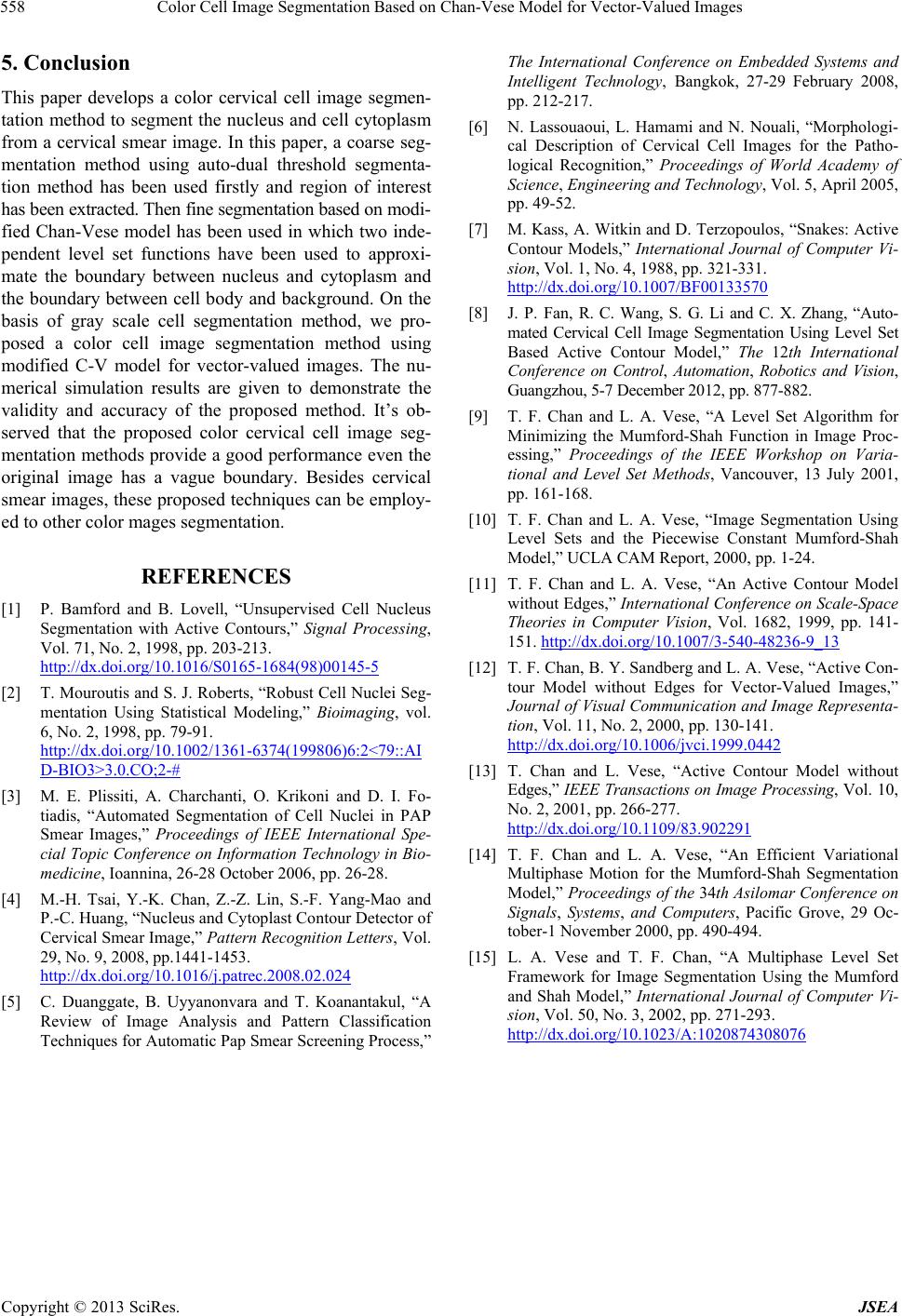
Color Cell Image Segmentation Based on Chan-Vese Model for Vector-Valued Images
558
5. Conclusion
This paper develops a color cervical cell image segmen-
tation method to segment the nucleus and cell cytoplasm
from a cervical smear image. In this paper, a coarse seg-
mentation method using auto-dual threshold segmenta-
tion method has been used firstly and region of interest
has been extracted. Then fine segmentation based on modi-
fied Chan-Vese model has been used in which two inde-
pendent level set functions have been used to approxi-
mate the boundary between nucleus and cytoplasm and
the boundary between cell body and background. On the
basis of gray scale cell segmentation method, we pro-
posed a color cell image segmentation method using
modified C-V model for vector-valued images. The nu-
merical simulation results are given to demonstrate the
validity and accuracy of the proposed method. It’s ob-
served that the proposed color cervical cell image seg-
mentation methods provide a good performance even the
original image has a vague boundary. Besides cervical
smear images, these proposed techniques can be employ-
ed to other color mages segmentation.
REFERENCES
[1] P. Bamford and B. Lovell, “Unsupervised Cell Nucleus
Segmentation with Active Contours,” Signal Processing,
Vol. 71, No. 2, 1998, pp. 203-213.
http://dx.doi.org/10.1016/S0165-1684(98)00145-5
[2] T. Mouroutis and S. J. Roberts, “Robust Cell Nuclei Seg-
mentation Using Statistical Modeling,” Bioimaging, vol.
6, No. 2, 1998, pp. 79-91.
http://dx.doi.org/10.1002/1361-6374(199806)6:2<79::AI
D-BIO3>3.0.CO;2-#
[3] M. E. Plissiti, A. Charchanti, O. Krikoni and D. I. Fo-
tiadis, “Automated Segmentation of Cell Nuclei in PAP
Smear Images,” Proceedings of IEEE International Spe-
cial Topic Conference on Information Technology in Bio-
medicine, Ioannina, 26-28 October 2006, pp. 26-28.
[4] M.-H. Tsai, Y.-K. Chan, Z.-Z. Lin, S.-F. Yang-Mao and
P.-C. Huang, “Nucleus and Cytoplast Contour Detector of
Cervical Smear Image,” Pattern Recognition Letters, Vol.
29, No. 9, 2008, pp.1441-1453.
http://dx.doi.org/10.1016/j.patrec.2008.02.024
[5] C. Duanggate, B. Uyyanonvara and T. Koanantakul, “A
Review of Image Analysis and Pattern Classification
Techniques for Automatic Pap Smear Screening Process,”
The International Conference on Embedded Systems and
Intelligent Technology, Bangkok, 27-29 February 2008,
pp. 212-217.
[6] N. Lassouaoui, L. Hamami and N. Nouali, “Morphologi-
cal Description of Cervical Cell Images for the Patho-
logical Recognition,” Proceedings of World Academy of
Science, Engineering and Technology, Vol. 5, April 2005,
pp. 49-52.
[7] M. Kass, A. Witkin and D. Terzopoulos, “Snakes: Active
Contour Models,” International Journal of Computer Vi-
sion, Vol. 1, No. 4, 1988, pp. 321-331.
http://dx.doi.org/10.1007/BF00133570
[8] J. P. Fan, R. C. Wang, S. G. Li and C. X. Zhang, “Auto-
mated Cervical Cell Image Segmentation Using Level Set
Based Active Contour Model,” The 12th International
Conference on Control, Automation, Robotics and Vision,
Guangzhou, 5-7 December 2012, pp. 877-882.
[9] T. F. Chan and L. A. Vese, “A Level Set Algorithm for
Minimizing the Mumford-Shah Function in Image Proc-
essing,” Proceedings of the IEEE Workshop on Varia-
tional and Level Set Methods, Vancouver, 13 July 2001,
pp. 161-168.
[10] T. F. Chan and L. A. Vese, “Image Segmentation Using
Level Sets and the Piecewise Constant Mumford-Shah
Model,” UCLA CAM Report, 2000, pp. 1-24.
[11] T. F. Chan and L. A. Vese, “An Active Contour Model
without Edges,” International Conference on Scale-Space
Theories in Computer Vision, Vol. 1682, 1999, pp. 141-
151. http://dx.doi.org/10.1007/3-540-48236-9_13
[12] T. F. Chan, B. Y. Sandberg and L. A. Vese, “Active Con-
tour Model without Edges for Vector-Valued Images,”
Journal of Visual Communication and Image Representa-
tion, Vol. 11, No. 2, 2000, pp. 130-141.
http://dx.doi.org/10.1006/jvci.1999.0442
[13] T. Chan and L. Vese, “Active Contour Model without
Edges,” IEEE Transactions on Image Processing, Vol. 10,
No. 2, 2001, pp. 266-277.
http://dx.doi.org/10.1109/83.902291
[14] T. F. Chan and L. A. Vese, “An Efficient Variational
Multiphase Motion for the Mumford-Shah Segmentation
Model,” Proceedings of the 34th Asilomar Conference on
Signals, Systems, and Computers, Pacific Grove, 29 Oc-
tober-1 November 2000, pp. 490-494.
[15] L. A. Vese and T. F. Chan, “A Multiphase Level Set
Framework for Image Segmentation Using the Mumford
and Shah Model,” International Journal of Computer Vi-
sion, Vol. 50, No. 3, 2002, pp. 271-293.
http://dx.doi.org/10.1023/A:1020874308076
Copyright © 2013 SciRes. JSEA